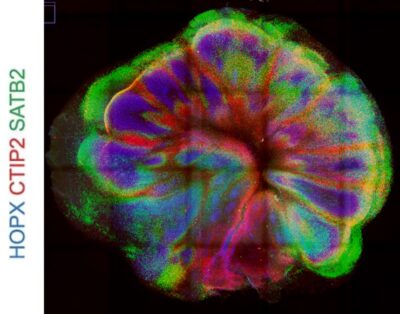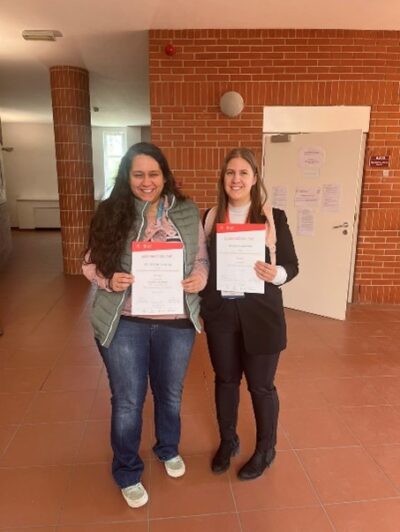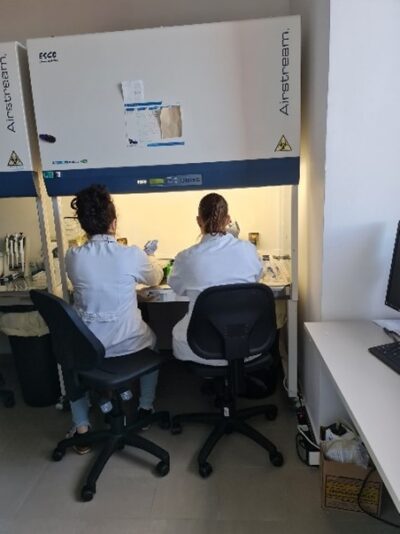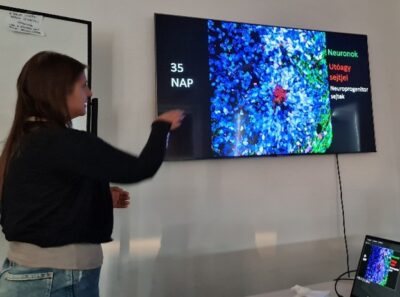Research focus
The focus of the laboratory is on developing human organoid models of diseases affecting the nervous system. This allows to uncover early, cell type-specific pathomechanisms. Understanding these can help to identify drug targets for treatment or prevention of the diseases.
The laboratory is specifically interested in neurodegenerative diseases such as amyotrophic lateral sclerosis and various types of cerebellar ataxias. Amyotrophic lateral sclerosis is a currently incurable neurodegenerative disease that affects motor neurons and glial cells of the forebrain and spinal cord and leads to a complete loss of muscle control and death within 3-5 years. Patients suffering from various types of cerebellar ataxias become severely limited in their movements, which is caused by pathological changes in one specific type of neurons in the cerebellum, the Purkinje neurons. In cooperation with the Drug Resistance group of the Research Institute for Natural Sciences and with the 2nd Department of Pediatrics, Semmelweis University, the laboratory also investigates neuroblastoma, a malignant tumour of the sympathetic nervous system, arising in the derivatives of the neural crest. Neuroblastoma mainly affects children under the age of 5 and is the most common cancer in infants. High-risk neuroblastoma is often fatal due to the resistance to therapy that develops during treatment.
For disease modelling purposes it is necessary to use models of the area affected by the disease therefore, the members of the laboratory are developing various protocols for cortical, spinal cord, cerebellar and neural crest organoids.

100 days old organoid slice with radial glia (HOPX), cortical layer II-IV (SATB2) and layer IV-VI neurons (CTIP2). Courtesy of Lea Wenger, modified from Szebényi et al., Nat Neurosci 2021.
Cells differentiating in organoids can become more mature than their counterparts created under two-dimensional culture conditions, leading to a higher ability to reveal disease phenotypes. The inclusion of organoids in drug development processes is therefore an extremely important task, but using three-dimensional tissues for high-throughput systems is still hindered by a few technical difficulties. With the help of a procedure developed by the principal investigator, certain cell types can be selected from the organoid models and propagated as two-dimensional cell cultures. These cultures are used by the laboratory currently to develop a high-throughput drug screening platform.
Lab members
Kornélia Szebényi, principal investigator (szebenyi.kornelia@ttk.hu)
Alexandra Sándor, PhD student
Wasifa Nurieva, visiting PhD student
Simon Tusnády, Scientific Students’ Associations (TDK) student
Funding
Szebényi, Kornélia
- IBRO Return Home Fellowship 2022
- FK OTKA
- HORIZON-WIDERA-2022-TALENTS-02-01
Sándor, Alexandra
- New National Excellence Programme
- Cooperative Doctoral Programme
Collaborations
Human Pluripotent Stem Cell Laboratory, Research Centre of Natural Sciences, Budapest, Hungary
Drug Resistance Research Group, Research Centre of Natural Sciences, Budapest, Hungary
2nd Department of Pediatrics, Semmelweis University, Budapest, Hungary
Lakatos Lab, Department of Clinical Neuroscience, University of Cambridge, Cambridge, United Kingdom
Ivics Lab, Medical Biotechnology Department, Paul Ehrlich Intézet, Langen, Germany
Selected publications
Szebényi K, Füredi A, Bajtai E, Sama SN, Csiszar A, Gombos B, Szabó P, Grusch M, Szakács G. Effective targeting of breast cancer by the inhibition of P-glycoprotein mediated removal of toxic lipid peroxidation byproducts from drug tolerant persister cells. Drug Resist Updat. 2023 Nov;71:101007. doi: 10.1016/j.drup.2023.101007. Epub 2023 Sep 17. PMID: 37741091.
Szebényi K, Barrio-Hernandez I, Gibbons GM, Biasetti L, Troakes C, Beltrao P, Lakatos A. A human proteogenomic-cellular framework identifies KIF5A as a modulator of astrocyte process integrity with relevance to ALS. Commun Biol. 2023 Jun 29;6(1):678. doi: 10.1038/s42003-023-05041-4. PMID: 37386082; PMCID: PMC10310856.
Szebényi K, Wenger LMD, Sun Y, Dunn AWE, Limegrover CA, Gibbons GM, Conci E, Paulsen O, Mierau SB, Balmus G, Lakatos A. Human ALS/FTD brain organoid slice cultures display distinct early astrocyte and targetable neuronal pathology. Nat Neurosci. 2021 Nov;24(11):1542-1554. doi: 10.1038/s41593-021-00923-4. Epub 2021 Oct 21. PMID: 34675437; PMCID: PMC8553627.
Szabó Z, Héja L, Szalay G, Kékesi O, Füredi A, Szebényi K, Dobolyi Á, Orbán TI, Kolacsek O, Tompa T, Miskolczy Z, Biczók L, Rózsa B, Sarkadi B, Kardos J. Extensive astrocyte synchronization advances neuronal coupling in slow wave activity in vivo. Sci Rep. 2017 Jul 20;7(1):6018. doi: 10.1038/s41598-017-06073-7. PMID: 28729692; PMCID: PMC5519671.
Füredi A, Szebényi K, Tóth S, Cserepes M, Hámori L, Nagy V, Karai E, Vajdovich P, Imre T, Szabó P, Szüts D, Tóvári J, Szakács G. Pegylated liposomal formulation of doxorubicin overcomes drug resistance in a genetically engineered mouse model of breast cancer. J Control Release. 2017 Sep 10;261:287-296. doi: 10.1016/j.jconrel.2017.07.010. Epub 2017 Jul 9. PMID: 28700899.
Szebényi K, Füredi A, Kolacsek O, Pergel E, Bősze Z, Bender B, Vajdovich P, Tóvári J, Homolya L, Szakács G, Héja L, Enyedi Á, Sarkadi B, Apáti Á, Orbán TI. Generation of a Homozygous Transgenic Rat Strain Stably Expressing a Calcium Sensor Protein for Direct Examination of Calcium Signaling. Sci Rep. 2015 Aug 3;5:12645. doi: 10.1038/srep12645. PMID: 26234466; PMCID: PMC4522653.
Szebényi K, Füredi A, Kolacsek O, Csohány R, Prókai Á, Kis-Petik K, Szabó A, Bősze Z, Bender B, Tóvári J, Enyedi Á, Orbán TI, Apáti Á, Sarkadi B. Visualization of Calcium Dynamics in Kidney Proximal Tubules. J Am Soc Nephrol. 2015 Nov;26(11):2731-40. doi: 10.1681/ASN.2014070705. Epub 2015 Mar 18. PMID: 25788535; PMCID: PMC4625667.
Szebényi K, Péntek A, Erdei Z, Várady G, Orbán TI, Sarkadi B, Apáti Á. Efficient generation of human embryonic stem cell-derived cardiac progenitors based on tissue-specific enhanced green fluorescence protein expression. Tissue Eng Part C Methods. 2015 Jan;21(1):35-45. doi: 10.1089/ten.TEC.2013.0646. PMID: 24734786; PMCID: PMC4291086.
Photos




